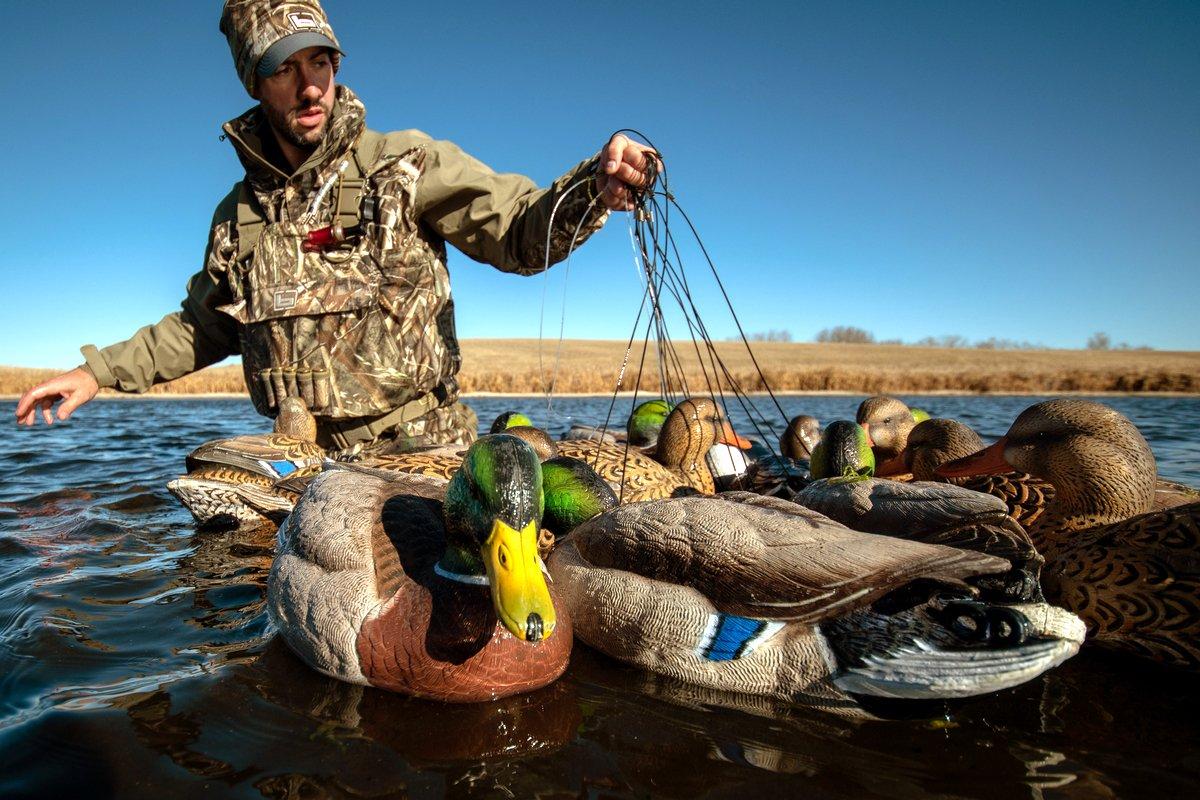From pothole puddlers to big-water cans, these situation-specific setups have you covered
Eight dozen of the best bluebill decoys rigged with 5-foot lines and egg sinkers do little good in the deep, rough waters of the Great Lakes. Likewise, superb mallard blocks with 25-foot lines look ridiculous in a shallow South Dakota pothole. If you're like me, you probably hunt various types of water and fields, which requires decoys rigged specifically for those situations. Here are five of my situation-specific approaches.
1. Shallow Marshes, Creeks and Flowages in the Early Season
This might be my most basic setup, because decoys for these low-maintenance hunts don't need long lines or heavy weights. Plus, I want to transport them by hand or in a small skiff. I use one- to two-dozen mallard, teal and wood duck blocks, Texas-rigged with 4-foot lines and 4-ounce weights. These light anchors allow easy transport, but they won't drift in the close-quarters, heavy-cover scenarios common during the early season. Best, Texas-rigged decoys make for easy setup and pickup.
2. General Puddle Duck Spread
For many mid- to late-season mallard scenarios, I need more versatility. I still use Texas-rigged blocks on 4-foot lines, but I go with 6-ounce weights to reduce wind drift on larger lakes and sandy bottoms. Also, I'll use heavy-keeled decoys that ride waves better than lighter models. It's tough to lug those heavier rigs by hand, but the added weight isn't a deal-breaker. And if I need to toss out three- or four-dozen, I can always transport them by skiff or boat.
3. Maximum Numbers, Walk-In Spread
When free-lancing the prairie, I usually have to hoof decoys over a quarter-mile or more of rough pasture or grassland. To cope, I use a setup that lets me take as many blocks as possible in one trip. Typically, I rig 17 to 20 puddle duck decoys — a mix of gaddies, wigeon and mallards — on 4-foot lines with 4- to 6-ounce scoop weights that fit snugly around a decoy's bill. Most of the blocks are light suck-duck or water-keel models, but I include a few heavier weighted-keel blocks that can ride the chop on windy days. I cram the blocks into a large, custom-made bag designed for walk-in hunts. The tight straps keep the weight on my shoulders and back, and the bag doesn't sag below my waist, so I don't trip over it with every step.
Note: I've also used J-shaped weights or egg sinkers with this rig, but I prefer scoop weights. They dig into muck better during windy conditions and don't drift as much.
4. Late-Season, Big-Water Mallards
When recreational boat traffic isn't an issue during late fall, mallards often roost and loaf on big water. That requires two- to three-dozen individually rigged mallard blocks with long lines and heavy weights. Typically, we'll rig the decoys for about 10 feet of water and use 8- to 12-ounce grapple-hook anchors or vinyl-coated H-shaped weights. The former resist drift better, but the latter typically weigh more. Obviously, we must transport these blocks by boat, and they're a bear to set out and pick up, especially when your hands are frozen. No one said duck hunting was easy.
Note: I've also tailored about 15 blocks for a deep kettle lake I sometimes hunt. I use ridiculously long lines (20 to 25 feet) so I can set a small spread in deep water next to shallow cover, boosting their visibility. Placing the blocks in the shallow bulrush and cattail cover would render them invisible.
5. Open-Water Divers
Big-water bluebills and cans demand large spreads, but the confines of a boat require efficiency. For open-water hunts, my partners and I run five 140-foot main lines (tarred nylon twine), attaching 13 or 14 ultra-heavy burlap-coated magnum decoys to each via 18-inch leaders and lobster-style clips. Each main line is anchored fore and aft with heavy window-sash weights.
Why five lines? Storage. We can store two on the rails of our boat, two on the floor and one in the bow. Some guys use lawn bags or other tricks, but this works for us. And why 13 to 14 decoys? That number fits well on the lines, leaving blocks 7 to 9 feet apart, with 20 to 25 feet of anchor line on each end. That provides ample leeway in the relatively shallow water (10 to 20 feet) where we typically set up.
Note: Sometimes, we'll take our rig to Lake Michigan and chase longtails in much deeper water (60 to 80 feet). The key? Extra-long clip-on leaders. We also attach two weights to each end so the lines don't drift in heavy swells.
Some of these rigging setups might work for you. Or maybe your hunting locales demand different approaches. That's part of the beauty of duck hunting: different and difficult spots require thoughtfully crafted solutions. Best, you can rig decoys all year — even during the doldrums of the off-season.
Click here for more Realtree waterfowl hunting content. And check us out on Facebook.







